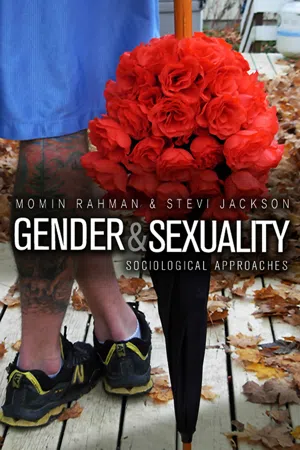
- English
- ePUB (mobile friendly)
- Available on iOS & Android
About this book
In an accessible and engaging style, the book demonstrates how thinking about gender and sexuality can illuminate and enliven other contemporary sociological debates about social structure, social change, and culture and identity politics. Emphasis is placed on the diversity of gendered and sexual lives in different parts of the world. The book offers detailed coverage of wide-ranging topics, from international sex-tourism to celebrity culture, from gender in the work-place to new sexual lifestyles, drawing examples from everyday life.
By demonstrating the links between gender and sexuality this book makes a clear case for thinking sociologically about these important and controversial aspects of human identity and behaviour. The book will be of great value to students in any discipline looking to understand the roles gender and sexuality play in our lives.
Frequently asked questions
- Essential is ideal for learners and professionals who enjoy exploring a wide range of subjects. Access the Essential Library with 800,000+ trusted titles and best-sellers across business, personal growth, and the humanities. Includes unlimited reading time and Standard Read Aloud voice.
- Complete: Perfect for advanced learners and researchers needing full, unrestricted access. Unlock 1.4M+ books across hundreds of subjects, including academic and specialized titles. The Complete Plan also includes advanced features like Premium Read Aloud and Research Assistant.
Please note we cannot support devices running on iOS 13 and Android 7 or earlier. Learn more about using the app.
Information
Part I
The Development of Sociological Thought on Gender and Sexuality
Introduction: The Unfortunate President
Lawrence H. Summers resigned yesterday as president of Harvard University after a relatively brief and turbulent tenure of five years, nudged by Harvard’s governing corporation and facing a vote of no confidence from the influential Faculty of Arts and Sciences.(The New York Times, 22 February 2006, Section A: 1)
1
The Trouble with ‘Nature’
1.1 ‘One is Not Born But Becomes a Woman’: Identifying ‘Essentialism’
Woman is a harp who only yields her secrets of melody to the master who knows how to handle her … what both man and woman, driven by obscure primitive urges, wish to feel in the sexual act, is the essential force of maleness, which expresses itself in a sort of violent and absolute possession of the woman. And so both of them can and do exult in a certain degree male aggression and dominance – whether actual or apparent – which proclaims this essential force. (T.H. Van de Velde, Ideal Marriage, 1930, quoted in Jackson, 1989: 62)
Table of contents
- Cover
- Title Page
- Copyright
- Introduction
- Part I The Development of Sociological Thought on Gender and Sexuality
- Part II Inequalities and Social Structure
- Part III Culture, Ideology and Discourse
- Part IV Self, Identity and Agency
- Part V Conclusion
- Bibliography
- Index
- End User License Agreement